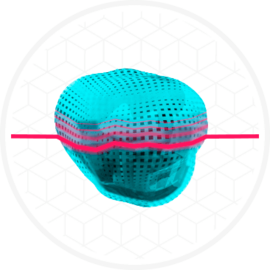Industry-leading technology
Our unique, multilayered approach to security
A single layer of defense is not enough in today’s constantly evolving threat landscape. ESET employs a multitude of proprietary, layered technologies, working together as ESET LiveSense, that goes far beyond the capabilities of basic antivirus. We also use advanced machine learning, which ESET pioneered to combat emerging threats. And we were among the earliest adopters of cloud technology, which powers our ESET LiveGrid® global reputation system to constantly update threat intelligence. Advances like these are the work of ESET’s team of dedicated people, who have been researching malware and innovating technology for more than three decades.
The ESET approach
ESET LiveSense technology, combined with our machine learning expertise, cloud reputation system, and our people, together power the world’s most formidable cyber threat prevention, detection and response platform.

UEFI Scanner
ESET was the first endpoint security provider to add a dedicated layer into its solution that protects the Unified Extensible Firmware Interface (UEFI). ESET UEFI Scanner checks and enforces the security of the pre-boot environment so that it is compliant with the UEFI specification. It is designed to detect malicious components in the firmware and report them to the user.
Show more
DNA Detections
Detection types range from very specific hashes to ESET DNA Detections, which are complex definitions of malicious behavior and malware characteristics.
While malicious code can be easily modified or obfuscated by attackers, the behavior of objects cannot be changed so easily and ESET DNA Detections are designed to take advantage of this principle.
Show more
Advanced Machine Learning
ESET products utilize two different forms of Advanced Machine Learning – a high-powered detection engine in the cloud and a lightweight version on the endpoint. Both employ a handpicked array of classification algorithms; among others, deep learning and boosted trees, that ensure rapid and accurate analysis necessary to stop emerging threats.
Show more
Cloud Malware Protection System
The ESET Cloud Malware Protection System is one of several technologies based on ESET’s LiveGrid® cloud system. Unknown, potentially malicious applications and other possible threats are monitored and submitted to the ESET cloud via the ESET LiveGrid® Feedback System.
Show more
Reputation & Cache
When inspecting a file or URL, before any scanning takes place, our products check the local cache for known malicious or allowlisted benign objects. This improves scanning performance.
Afterwards, our ESET LiveGrid® Reputation System is queried for the object’s reputation (i.e. whether the object has already been seen elsewhere and classified as malicious). This improves scanning efficiency and enables faster sharing of malware intelligence with our customers.
Show more
Behavioral Detection and Blocking - HIPS
ESET Host-based Intrusion Prevention System (HIPS) uses a predefined set of rules to look for suspicious activities and to monitor and scan behavioral events such as running processes, files and registry keys. When identified, HIPS reports the offending item and – if further analysis is necessary – requests deeper inspection using other ESET technology layers.
Show more
In-Product Sandbox
Today’s malware is often heavily obfuscated and tries to evade detection as much as possible. To see through this and identify the real behavior hidden underneath the surface, we use in-product sandboxing. With the help of this technology, ESET solutions emulate different components of computer hardware and software to execute a suspicious sample in an isolated virtualized environment.
Show more
Advanced Memory Scanner
Advanced Memory Scanner is a unique ESET technology which effectively addresses an important issue of modern malware – heavy use of obfuscation and/or encryption. To tackle these issues, Advanced Memory Scanner monitors the behavior of a suspicious process and scans it once it decloaks in memory.
Show more
Exploit Blocker
Exploit Blocker monitors typically exploitable applications (browsers, document readers, email clients, Flash, Java, and more) and instead of just aiming at particular CVE identifiers it focuses on exploitation techniques. When triggered, the behavior of the process is analyzed and, if it is considered suspicious, the threat may be blocked immediately on the machine.
Show more
Ransomware Shield
ESET Ransomware Shield is an additional layer protecting users from ransomware. This technology monitors and evaluates all executed applications based on their behavior and reputation. It is designed to detect and block processes that resemble behavior of ransomware.
Show more
Network Level Protection
ESET also uses a broad line of detection technologies to identify threats attempting to penetrate victim’s environment on the network level. The list includes detection of malicious network communication, exploitation of yet unpatched vulnerabilities and brute-force attacks against a variety of protocols such as Remote Desktop Protocol, SMB and SQL.
Connected Home
Our Connected Home layer has been designed to reveal what is happening on users’ Wi-Fi networks and get the most out of their connected devices and smart home setups. It also helps users identify vulnerabilities in their home networks such as unpatched firmware flaws in their routers, open ports and weak router passwords.











